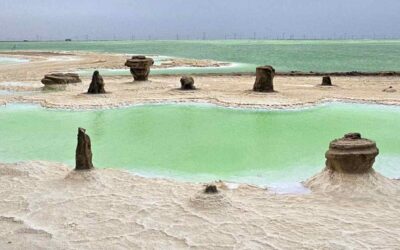Jiayuguan Pass – the Great Wall on the Silk Road
Jiayuguan Pass or Jiayu Pass, as guan means pass in Chinese is one of the most remarkable monuments on the Silk Road and one of its most popular sights. Built at the end of the Great Wall, showing the desolation of the great deserts beyond, it is the last view of the Chinese world for travelers leaving the country, or the first for those arriving from the solitudes of the desert. The pass is therefore one of the most powerful symbols of this trade route that for millennia connected China with the cultures located further west.
The Jiayuguan Pass is both a beautiful symbol, experts say it is the best-preserved gate of the entire Great Wall. And its location there, defying the sands that have already engulfed cities and temples, and the winds that have turned cities formerly the scene of bustling lives into mere sketches of sinuous lines, gives it even more value, for it allows us to transpose its reality to that of cities already lost forever. As seen in Chinese movies.
In reality, if the Jiayu Pass is so well preserved, it is because it is relatively recent. Its construction began in 1372 by the general Feng Sheng, to secure the terrain after his victory over the Mongols, and lasted more than 150 years, not being completed until 1540. It was one of the most important defensive elements that the Ming dynasty had to keep at bay, not always successfully, the Mongols it had to expel from China to seize power. There is no doubt that during those centuries it was one of the most important military posts of the empire.
Built at the foot of the hill of the same name, the Jiayu Pass is located at the narrowest point of the western section of the Hexi Corridor and is surrounded by imposing mountains to the south and desert hills to the north, which protect a desert valley about 15 kilometers wide. The end point of the Great Wall, now called the First Strategic Point is about 8 km north of the pass.
The architects who contributed to the construction of the fortress are among the most famous of the times, which not only explains its majestic, sober, imposing, unforgettable form but also gives veracity to the legend that says that he calculated so accurately the number of bricks needed for its construction, that at its completion only one was left over, which today is displayed in the gate’s outbuildings.
For a long time the fort was considered the last landmark of civilization before entering the vast Gobi desert. A feeling the traveler still experiences when looking out over the desert from the fortress, and even more so if one goes all the way to the end of the Great Wall. And in the time of the Ming dynasty it was a place of banishment for those punished for certain crimes.
Seen from a distance, the fortress is already impressive. Its courtyard has a perimeter of 640 meters and an area of 25,000 square meters. It has a two-story watchtower at each corner. And a gate of three floors and 17 meters high with gable roofs. It is said that this tower was not built from bottom to top, but from top to bottom. Skilled craftsmen piled a huge mound of earth on top of the wall and built the tallest one, then the earth was dug out and the second one was built and the process was repeated for the lowest one. It still stands firm as a rock, after centuries of winds, raids and earthquakes. As you can see, the castle has great architectural and cultural value and its towers and pavilions are of great beauty.
The old garrison used to have a thousand troops. In front of the fortress there is a spring that forms an oasis, one of the reasons why the fortress was built there. During the Qing dynasty, after the final defeat of the Mongols and the incorporation of Xinjiang to China, its military importance declined, the garrison was reduced and the activity decreased considerably, remaining practically as a toll point where merchants paid to pass.
Last posts
Discover China’s Largest and Most Beautiful Salt Lake
Discover China’s Largest and Most Beautiful Salt Lake The development of tourism and transportation in China is bringing to light places that were previously very hard to access and virtually unknown. Some of these destinations are beginning to gain a certain...
A Giant Mandala in the Heart of Tibet
A Giant Mandala in the Heart of Tibet The Palkor of Gyantze is one of Tibet’s great marvels and a unique jewel of universal architecture and art. Its shape, scale, and iconography defy comparison with any other construction. Amidst some of the highest mountains of...
The Largest Collection of Paintings from ancient China
The Largest Collection of Paintings from ancient China No one doubts that pictorial art has existed in China since time immemorial. In fact, some painted pottery vessels, several thousand years old, continue to intrigue archaeologists who try to unravel their ultimate...







